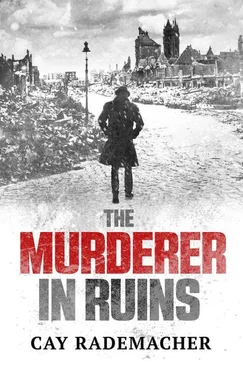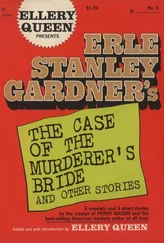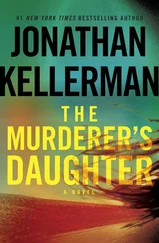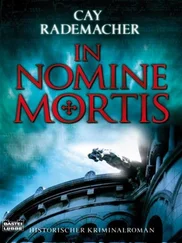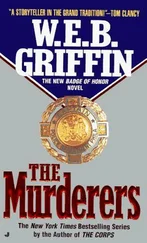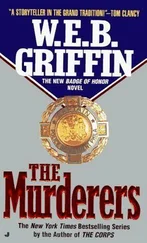Cay Rademacher - The Murderer in Ruins
Здесь есть возможность читать онлайн «Cay Rademacher - The Murderer in Ruins» весь текст электронной книги совершенно бесплатно (целиком полную версию без сокращений). В некоторых случаях можно слушать аудио, скачать через торрент в формате fb2 и присутствует краткое содержание. Год выпуска: 2015, ISBN: 2015, Издательство: Arcadia Books Limited, Жанр: Триллер, на английском языке. Описание произведения, (предисловие) а так же отзывы посетителей доступны на портале библиотеки ЛибКат.
- Название:The Murderer in Ruins
- Автор:
- Издательство:Arcadia Books Limited
- Жанр:
- Год:2015
- ISBN:9781910050750
- Рейтинг книги:5 / 5. Голосов: 1
-
Избранное:Добавить в избранное
- Отзывы:
-
Ваша оценка:
- 100
- 1
- 2
- 3
- 4
- 5
The Murderer in Ruins: краткое содержание, описание и аннотация
Предлагаем к чтению аннотацию, описание, краткое содержание или предисловие (зависит от того, что написал сам автор книги «The Murderer in Ruins»). Если вы не нашли необходимую информацию о книге — напишите в комментариях, мы постараемся отыскать её.
The Murderer in Ruins — читать онлайн бесплатно полную книгу (весь текст) целиком
Ниже представлен текст книги, разбитый по страницам. Система сохранения места последней прочитанной страницы, позволяет с удобством читать онлайн бесплатно книгу «The Murderer in Ruins», без необходимости каждый раз заново искать на чём Вы остановились. Поставьте закладку, и сможете в любой момент перейти на страницу, на которой закончили чтение.
Интервал:
Закладка:
He dragged himself up the staircase to his apartment, no longer trying to hide his limp. The stairwell was dark anyway. He was almost expecting to find Ruge or another uniformed policeman outside his door, with more, almost certainly, bad news. But the landing by his doorway was deserted. Stave unlocked the door, then carefully locked it behind him. He threw himself down on the tatty sofa, still wearing his coat and hat. It was freezing cold. He ought to go into the kitchen to get himself a bite to eat, but he was too exhausted. Anna. Don’t think of her. The chief inspector fell asleep on the sofa, his last thought before slipping into oblivion was astonishment at how weary he really was.
Number Four
Wednesday, 12 February 1947
Hell, Stave thought to himself, isn’t hot – it’s cold.
When he looked out of his office window he saw houses that had been cleaned automatically, their roofs and north or east gable walls blasted by a wind that had sucked up Arctic ice and used it to sand the tiles and plaster like an invisible plane. In places sheltered from the blast of the wind there were still pockets of sheet ice and layers of powder snow on the guttering, window frames and in the empty door-frames of bombed-out houses. The temperature had been constant since January, but the light had changed: for eight hours a day now there was a blue-shimmering sun in a cloudless sky, bathing the world in an eerie brightness that highlighted even the smallest of details. The cracks in the facade of the Music Hall on the square opposite looked to the chief inspector like a Durer engraving, each cracked capital on the columns casting grotesque shadows. Yet here I am typing in the dark, Stave mused; it was a bad joke.
Dr Czrisini’s third autopsy report was lying in his in-tray. Assumed date of death: twentieth of January. No other significant details. Stave wondered how many other people had been killed on that day – and when they would find their bodies.
Kleensch had published his article in Die Zeit : a measured piece with no absurd speculation, no hysteria, no inflated suggestion of hope – just enough to indicate that the police were making progress. Stave had warned Cuddel Breuer and Ehrlich in advance so they would not feel they were hearing it for the first time from the press.
But apart from that, nothing.
He had posted men near the Lappenbergs Allee crime scene, a pretty grim job in this cold. And now a few deep-frozen, bored-stiff officers hated him for it, because nobody had turned up. No reaction on the part of the killer, no information from the public, no new leads. Nothing, nothing, nothing.
No news either from Anna von Veckinhausen. Had she seen the article? Was she furious at him? Stave had asked MacDonald to check out her story about the sale of the kitsch painting. It appeared to be true. MacDonald hadn’t exactly identified which of his comrades-in-arms had bought the item of dubious value, but Anna von Veckinhausen was, it turned out, known to many British officers, who appreciated the goods she sold. The lieutenant had let him know in the nicest possible way that many of his superior officers would be extremely unhappy if her supply chain was interrupted. The chief inspector had just nodded and muttered something incomprehensible, but he had got the message.
He wouldn’t be able to threaten Anna von Veckinhausen with charges for her looting or dealings on the black market. Either she cooperated voluntarily or she didn’t. And if she did have something to do with the murders, then he had better have proper evidence before he arrested her.
As for ‘Bottleneck’, MacDonald had got nowhere. And Hellinger, the industrialist, was still missing.
Maschke had gone round all the older, retired doctors – it was his own idea and he had got their numbers from the medical council. He had asked all of them about the victims, the old man in particular. In vain. It had been a good idea though, Stave reckoned. He should have thought of it himself. The vice squad man was getting better and better.
Stave sat and stared at the thin files he had placed carefully next to one another on his desk. Three investigation files. Three murder cases. Three single sheets of paper and a few photos. Could it be that the solution to the case lay in these sparse files? Could he have overlooked something?
It was exactly midday when his door flew open, and Maschke charged in.
‘Ever heard of knocking first?’ Stave asked.
‘We have a new murder,’ the vice squad man blurted.
‘This time, I’ll drive,’ Stave told him in no uncertain terms two minutes later as they climbed into the old Mercedes. ‘What’s the story?’
‘We have a fresh corpse.’
‘Who is it?’
‘A man in a cellar, in Borgfelde, behind the Berliner Tor station. Just been found. It was reported to the local police station around 11.30.’
‘In the east of the city again.’
‘And another heavily bombed area.’
Stave put his foot down, racing down to the Alster and along the Jungfernstieg, pushing the old eight-cylinder as hard as it would go, and blaring his horn when a man in a Wehrmacht greatcoat didn’t get out of the way quickly enough. Maschke’s knuckles were white as he hung on for dear life to the passenger door handle.
‘Don’t worry, the police won’t stop us,’ the chief inspector assured him.
Four bodies: two men, one woman and one little girl. Three of the corpses found in the east of the city, this latest approximately halfway between where the body of the first, the young woman, had been found and where the girl had been found near the canal. Was there a pattern emerging?
‘52 Anckelmann Strasse,’ Maschke only just managed to tell him.
Stave took the corner into Glockengiesserwall, the Mercedes swerving wildly when one rear wheel hit a roof tile frozen to the road, but he got it back under control.
‘A bit icy in patches,’ Maschke gasped.
‘I’m beginning to enjoy myself.’
Past the main station, then through St Georg. Black marketeers stared in their wake. When they reached Borgfelder Strasse, Stave put his foot down again. Half a kilometre, dead straight. Nobody around. Then two sharp right turns, and with a screech of brakes he brought the car to a halt.
‘One dead body a day is more than enough,’ Maschke muttered as he opened his door.
Stave climbed out too, leaning briefly against the vehicle’s dented hood. The engine was ticking as it cooled down. For a few moments, Stave held his hands on the hood, enjoying the warmth as it flowed into his veins like a hot liquid.
‘That feels good, doesn’t it?’
‘I’m quite hot enough,’ Maschke answered drily.
The chief inspector looked around; behind them stood the steel supports for the elevated railway, every sixth or seventh twisted and bent, empty facades of burnt-out apartment blocks, four or five storeys high, bombed-out office buildings, half-demolished warehouses. The cobbled street had been partly cleared, but there wasn’t a habitable building for at least 300 metres in any direction.
A pattern, Stave thought to himself, I’m starting to see a pattern.
A uniformed policeman emerged from between two half-height walls to their right, waved and came over. He was extremely young, little more than a kid. Stave had never seen him before. He gave them an almost military salute, looking as if he was about to stand to attention.
‘As you were,’ Stave said, introducing himself and Maschke. The lad had probably fought in the Wehrmacht. There were one or two habits he needed to lose. ‘Where is the man?’
‘It’s a woman, Chief Inspector.’
Stave stared at the young policeman, embarrassing him.
‘Two men found the body. In an unlit cellar. They ran out in panic and reported it to us. They thought it was a male corpse, but they obviously didn’t look close enough. It’s a woman.’
Читать дальшеИнтервал:
Закладка:
Похожие книги на «The Murderer in Ruins»
Представляем Вашему вниманию похожие книги на «The Murderer in Ruins» списком для выбора. Мы отобрали схожую по названию и смыслу литературу в надежде предоставить читателям больше вариантов отыскать новые, интересные, ещё непрочитанные произведения.
Обсуждение, отзывы о книге «The Murderer in Ruins» и просто собственные мнения читателей. Оставьте ваши комментарии, напишите, что Вы думаете о произведении, его смысле или главных героях. Укажите что конкретно понравилось, а что нет, и почему Вы так считаете.
